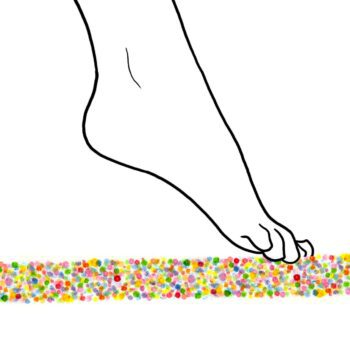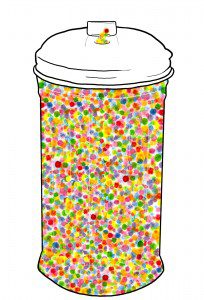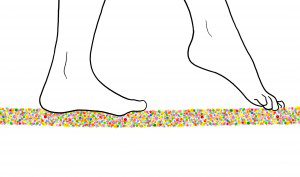
Not long ago, I was fortunate to take a two-day class with Philippe Petit, the virtuoso wirewalker who famously rigged a wire illegally between the roofs of the World Trade Center towers, and then walked back and forth across it eight times on the morning of August 7, 1974, when he was merely 25 years old.
I was not at the class to learn about wirewalking, although that was ostensibly what the class was about. I was there to learn about space, I thought, from someone who clearly has a genius’s understanding of it.
I did not exactly learn what I came for.
I stumbled through class as best I could, however, trying to be game as PP, as I called him in my head, imparted to us various details of the wirewalker’s art, and asked us several times to trek across the elevated wire—thankfully, only about seven feet up—in the dance studio in Brooklyn where the class took place.
We did one exercise, however, where my ears perked up.
In it, PP asked us to take our prop—assuming we were jugglers, say, these would be our balls or clubs—and to formulate a move that would serve as a way of greeting it, of grounding ourselves with it, and of waking it up.
As a writer, I suppose that my true prop would have been my computer, but I did not have the balls to try to work my computer into class, or to mention my art at all in proximity with such a master: I chose one of the white juggling balls he offered without comment.
As we stood there with our props, he reminded us that these greetings we were creating could be very simple.
As I was figuring out a way to say hello in a meaningful way to my ball, I was smiling, and I thought: this does not seem stupid to me. Why?
I thought of my Italian design heroes, and in particular, the men and women who have designed for Alessi, and how they understand the idea that objects have spirits, and how it is worth time and energy to create a sugar-pourer, for instance, that is shaped like a standing, smiling, neon-colored, human breast.
These designers understand the significance of greeting the object, and, more importantly, realize that most people fail to do this, not out of laziness but a lack of consciousness; they then work to reverse this situation by creating objects that overtly and unmistakably, greet us. This, to my mind, is not frivolous: all the friendly, huggable, salt shakers and paper towel holders in the Italian kitchen store are nothing less than a heroic attempt to change human perspective. This is an art in the same league as painting and poetry.
We have relationships with objects that we do not understand. We think, foolishly, that we are the sole living things in a dead world, that we live and breathe and are conscious and move around in a landscape where every thing, every sugar pourer around us, cannot die, and thus is already dead. This is truly a harsh, black-and-white landscape we have made for ourselves.
 I would argue that every time we hold the sugar pourer over the hot coffee, and calibrate the amount of sugar we want in the cup, we and the sugar pourer are one. This is part of what PP knew, and demonstrated, taking his life, and attaching it to a stick, a quarter of a mile over downtown Manhattan, one summer morning in the 1970s.
I would argue that every time we hold the sugar pourer over the hot coffee, and calibrate the amount of sugar we want in the cup, we and the sugar pourer are one. This is part of what PP knew, and demonstrated, taking his life, and attaching it to a stick, a quarter of a mile over downtown Manhattan, one summer morning in the 1970s.
Fiddling with my ball, trying to solve the problem of the exercise, I thought of my daughter when she was two, during a phase when she said hello—a squealing, delighted “Hi!”—to all things animate and inanimate; who greeted, with equal, unmitigated pleasure, live puppies, stuffed puppies, and dog poop on the sidewalk.
Why do we ever stop saying “Hi!” to everything? How is this understanding that the entire world is worthy of our conscious consideration, ever lost?
In class, we took turns demonstrating our moves.
I nervously popped my ball lightly from one hand to the other, an almost-nothing gesture.
PP nodded approvingly.
***
At the end of the first day of class, PP pointed to the wire that was carefully suspended about 6 feet overhead and said that, as the last activity of the day, we would have our “baptismal walk.”
I was about to have a heart attack—I had realized rather quickly that, although I would not call myself uncoordinated, I do not have anything near the physical capabilities required to be a wirewalker of even the lowliest sort—when PP explained what this meant: he would walk across the wire with his balancing pole, and we would walk behind him, with our hands on his shoulders, and a safety harness on.
I exhaled. OK, I thought. I can handle that.
I did not think it was going to be a big deal, walking behind PP, world-famous, never-falling wirewalker, with a safety harness on, a harness secured by PP’s gentle giant of an assistant, Zaire Baptiste.
In ascertaining the situation enough so that I believed it very unlikely that I would die during the walk, however, and then resuming what was essentially an auto-pilot approach, I simply ping-ponged between the two poles: There, death will not get me/us here, in this particular place, I thought. There, I’m done. I’m done thinking about, or paying attention, really, to whatever else it is that will happen.
If you had asked me, in fact, what do you think it will be like, walking across a tightrope with a safety harness on, behind master-wirewalker Philippe Petit, I probably would have told you, unmoved: it will be like walking.
This would be a nervous, distracted, afraid-to-die person’s way of talking.
What is walking, anyway? I see a bag of potato chips on the table. I am a head, disembodied, floating towards a crinkly bag of salty, fatty goodness.
Must.
Get.
Chips.
This is what walking is like, sometimes.
I was standing on the small, metal platform in my sweatpants behind PP, who was also standing, only with one foot on the metal platform, and one foot on the wire. I had my hands on PP’s shoulders. He did not have his hands on me. He was holding his 22-foot balancing pole against his waist.
He was wearing his class uniform: a black sleeveless shirt and black pants. It was a hot day, even for August in the city. The dance studio had no AC. We were sweating. I could smell him, human-flowery.
I shifted my weight on my feet a bit up there, trying to find something.
There was no finding anything.
I stood still.
PP seemed to have been waiting for this settling. With his back to me, in his French accent, he asked me, gently: “Shall we go?”
He had already explained that he reserved the right not to take someone on the wire for a baptismal walk, and that the reasons he might not take them would be: if they were obese, if they were drunk, if they were not in the “right” frame of mind. What the “right” frame of mind was, he did not explain, but I think it is safe to say we assumed—there were four students in class besides me—we all had it.
He noted, however, that this same privilege was also ours: we could refuse our baptismal walk if we wanted. And that’s why, after all the preparation was done, after we had observed how the cable, which had been fashioned specifically to PP’s specifications for this class, was rigged securely and under appropriate tension; after we had clambered more or less awkwardly up the ladder to the metal platform, and put the safety harness on; after we had checked that we were completely buckled into the harness; after we had tested the harness, and knew that Zaire held it firmly; after all of that, in the final moment: PP asked us this question.
And in this asking, he reminded us that after all he had done to make this walk possible (which was to say, pretty much everything) we still held tremendous power in it, because, despite the magnitude of his efforts in relation to our own, it was only possible for the two of us to do this action together if each one of us, individually, first did something alone, which was internal, and invisible, and this was: to agree to fly with him with the understanding that we would could only do this—the impossible—because we had surrendered to him in a way that was not meek and resentful but assertive and glad.
 “Yes,” I said, and picked up my right foot from the platform and placed it gently on the steel cable.
“Yes,” I said, and picked up my right foot from the platform and placed it gently on the steel cable.
I remember an elementary school gym teacher once telling my class that walking is not a controlled activity at all–it’s merely a more or less well-managed falling that we have grown accustomed to doing without recognizing what it is, which is, essentially, hurling ourselves into space and then catching ourselves, as if each of us we were always, all together, the entire game: pitcher, catcher, and ball.
I picked up my left foot, hurled myself, then caught myself. And then I did it again and again, like it was nothing.
***
Rumpus original art by Sam Geer.




